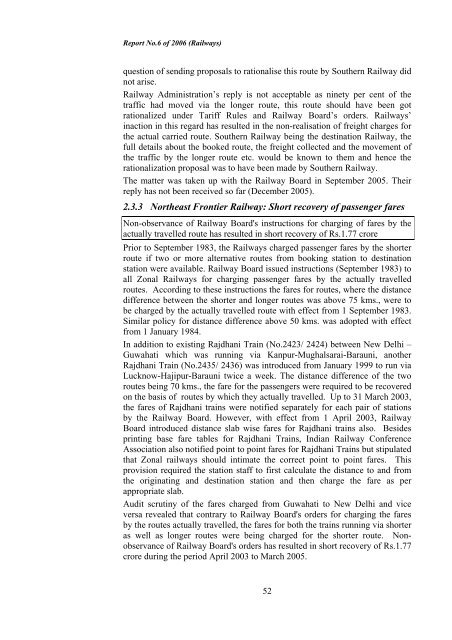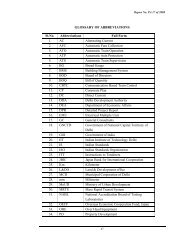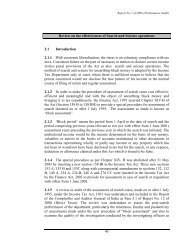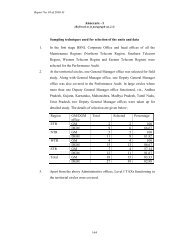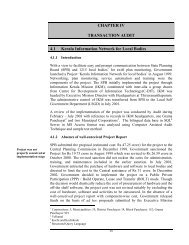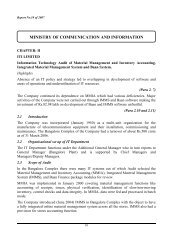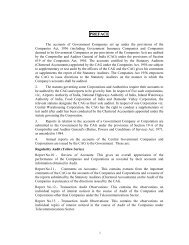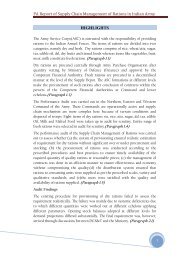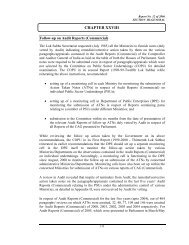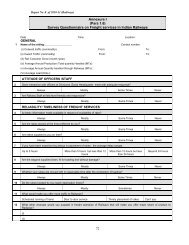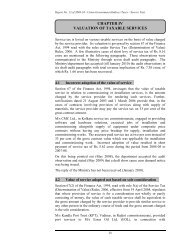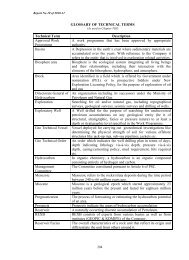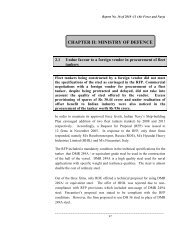Earnings - Comptroller and Auditor General of India
Earnings - Comptroller and Auditor General of India
Earnings - Comptroller and Auditor General of India
You also want an ePaper? Increase the reach of your titles
YUMPU automatically turns print PDFs into web optimized ePapers that Google loves.
Report No.6 <strong>of</strong> 2006 (Railways)question <strong>of</strong> sending proposals to rationalise this route by Southern Railway didnot arise.Railway Administration’s reply is not acceptable as ninety per cent <strong>of</strong> thetraffic had moved via the longer route, this route should have been gotrationalized under Tariff Rules <strong>and</strong> Railway Board’s orders. Railways’inaction in this regard has resulted in the non-realisation <strong>of</strong> freight charges forthe actual carried route. Southern Railway being the destination Railway, thefull details about the booked route, the freight collected <strong>and</strong> the movement <strong>of</strong>the traffic by the longer route etc. would be known to them <strong>and</strong> hence therationalization proposal was to have been made by Southern Railway.The matter was taken up with the Railway Board in September 2005. Theirreply has not been received so far (December 2005).2.3.3 Northeast Frontier Railway: Short recovery <strong>of</strong> passenger faresNon-observance <strong>of</strong> Railway Board's instructions for charging <strong>of</strong> fares by theactually travelled route has resulted in short recovery <strong>of</strong> Rs.1.77 crorePrior to September 1983, the Railways charged passenger fares by the shorterroute if two or more alternative routes from booking station to destinationstation were available. Railway Board issued instructions (September 1983) toall Zonal Railways for charging passenger fares by the actually travelledroutes. According to these instructions the fares for routes, where the distancedifference between the shorter <strong>and</strong> longer routes was above 75 kms., were tobe charged by the actually travelled route with effect from 1 September 1983.Similar policy for distance difference above 50 kms. was adopted with effectfrom 1 January 1984.In addition to existing Rajdhani Train (No.2423/ 2424) between New Delhi –Guwahati which was running via Kanpur-Mughalsarai-Barauni, anotherRajdhani Train (No.2435/ 2436) was introduced from January 1999 to run viaLucknow-Hajipur-Barauni twice a week. The distance difference <strong>of</strong> the tworoutes being 70 kms., the fare for the passengers were required to be recoveredon the basis <strong>of</strong> routes by which they actually travelled. Up to 31 March 2003,the fares <strong>of</strong> Rajdhani trains were notified separately for each pair <strong>of</strong> stationsby the Railway Board. However, with effect from 1 April 2003, RailwayBoard introduced distance slab wise fares for Rajdhani trains also. Besidesprinting base fare tables for Rajdhani Trains, <strong>India</strong>n Railway ConferenceAssociation also notified point to point fares for Rajdhani Trains but stipulatedthat Zonal railways should intimate the correct point to point fares. Thisprovision required the station staff to first calculate the distance to <strong>and</strong> fromthe originating <strong>and</strong> destination station <strong>and</strong> then charge the fare as perappropriate slab.Audit scrutiny <strong>of</strong> the fares charged from Guwahati to New Delhi <strong>and</strong> viceversa revealed that contrary to Railway Board's orders for charging the faresby the routes actually travelled, the fares for both the trains running via shorteras well as longer routes were being charged for the shorter route. Nonobservance<strong>of</strong> Railway Board's orders has resulted in short recovery <strong>of</strong> Rs.1.77crore during the period April 2003 to March 2005.52


